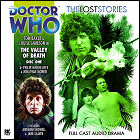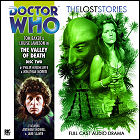 1873: Renowned explorer Professor Cornelius Perkins ventures into the Amazon rainforest to follow up on clues that might lead him to a legendary lost city of gold. He, his assistant and the locals they’ve hired to haul their supplies are never seen again, though a diary chronicling some of his discoveries turns up at a later date in surprisingly good shape.
1873: Renowned explorer Professor Cornelius Perkins ventures into the Amazon rainforest to follow up on clues that might lead him to a legendary lost city of gold. He, his assistant and the locals they’ve hired to haul their supplies are never seen again, though a diary chronicling some of his discoveries turns up at a later date in surprisingly good shape.
1977: Edward Perkins, great-grandson of Cornelius Perkins, announces his intention to follow up on the lost expedition, using his great-grandfather’s journal as a guide. The Doctor, with Leela in tow, pulls rank as a UNIT observer and gets himself added to the new expedition. A freak storm brings the plane down near the Amazon River, requiring all of the Doctor’s piloting skills to bring the plane to a survivable crash landing. As the Doctor and photojournalist Valerie Carlton go exploring on foot and find what appears to be a downed (but not destroyed) UFO, Leela and Perkins discover signs of advanced technology and are taken to a creature called Godrin, worshipped by the natives but careful to conceal himself since he’s obviously not from Earth. Godrin has another surprise: thanks to a time bubble he has erected around his crashed spaceship, time is dilated, and Cornelius Perkins is still alive, the only survivor of the 1873 expedition and the last person Edward expected to find. Godrin proposes a peaceful exchange with the people of Earth, but once the Doctor brings him back to London, he realizes that Godrin has been far from truthful about his real intentions. Godrin and the last of his people are ready to begin the stealth colonization of Earth, and by bringing him into modern civilization, the Doctor has made this invasion possible.
written by Philip Hinchcliffe
adapted by Jonathan Morris
directed by Ken Bentley
music by Andy HardwickCast: Tom Baker (The Doctor), Louise Jameson (Leela), Nigel Carrington (Emissary Godrin / Dr. Summersby / Announcer), Delia Lindsay (Overlord Saldor / Newsreader), Jane Slavin (Valerie Carlton), Anthony Howell (Edward Perkins), David Killick (Professor Cornelius Perkins), Richard Bremmer (General Hemmings / Valcon / Taxi Driver)
Timeline: after The Horror Of Fang Rock and before The Invisible Enemy
Notes: Originally devised by producer Philip Hinchcliffe as a story for Doctor Who’s 15th season, The Valley Of Death was shelved when Hinchcliffe’s successor, Graham Williams, was given orders from the BBC brass to tone down the gothic horror elements that characterized the much-acclaimed but occasionally controversial tenure of Hinchcliffe and his script editor, Robert Holmes. Leela mentions that she has been blinded once before, a reference to the conclusion of The Horror Of Fang Rock (a scene added to that story at a late stage sees Leela temporarily blinded, resulting in her eyes turning blue, allowing actress Louise Jameson to ditch the brown contact lenses that were causing her considerable pain), so Valley Of Death a la Big Finish happens at some point after that story and, due to the absence of K-9, presumably before the television story that immediately follows it, The Invisible Enemy.
LogBook entry and TheatEar review by Earl Green
Review: This is much more like it, just pitch perfect Tom Baker-era Doctor Who. If I had listened to Valley Of Death before hearing Destination Nerva, I might have had a much better vibe toward the fourth Doctor audio adventures from Big Finish; as it is, I’m now even more disappointed that the fourth Doctor’s new stories are mere two-parters.
Valley Of Death isn’t even an especially strong story on its own merits: there’s very little here that hasn’t been done elsewhere, from the invasion force using sly methods to subjugate a much larger populace to the cloning/duplication angle to the time dilation plotline. If it had been produced in 1977, Valley Of  Death would have suffered from BBC-sized execution of the script’s Hollywood aspirations, only to wind up being a fairly average and occasionally derivative story.
Death would have suffered from BBC-sized execution of the script’s Hollywood aspirations, only to wind up being a fairly average and occasionally derivative story.
Where Valley succeeds spectacularly is in delivering on the promise of Tom Baker a la Big Finish, and delivering in a way that Destination Nerva didn’t: Valley, at four parts, just feels more appropriate than Nerva, which was a rushed, single-disc two-parter. Baker still gets his humorous and sometimes just plain surreal licks in (the “interview with God!!!” scene is bizarrely over the top), but the Doctor deals with events on a serious basis and the whole thing unfolds like a tape recording of a lost ’70s story. It’s Tom Baker as the Doctor, not the indulgent more-Tom-than-the-Doctor stuff we occasionally got from the BBC Audio/Paul Magrs stories. Louise Jameson is on top form, once again making Leela a noble savage with a strict code of honor; both Leela and that code of honor are only crossed at one’s own peril.
The rest of the cast brings their “A” game as well – a requirement when the larger-than-life fourth Doctor could upstage any of them with a single quip. Almost everyone gets to play two characters in this story, and the differences between characters is pretty sharply defined by both their performances and some subtle post-production effects. The sound design and music are top-notch, even though the music is very much standard-issue Big Finish – it doesn’t seem like any attempt was made to stay within the stylistic parameters of Dudley Simpson. It fits the story, but is slightly out-of-place against the era that the story is meant to evoke.
Valley Of Death is such a relief; for whatever its minor faults may be, hearing the fourth Doctor in the four-part format that suited him so well, it’s this story that makes me think that Big Finish fourth Doctor stories may have some real potential. The new scripts just need to match the feel of the unproduced stories revived for the Lost Stories box set.
